Xiangxiang Chu
Advancing End-to-End Pixel Space Generative Modeling via Self-supervised Pre-training
Oct 14, 2025Abstract:Pixel-space generative models are often more difficult to train and generally underperform compared to their latent-space counterparts, leaving a persistent performance and efficiency gap. In this paper, we introduce a novel two-stage training framework that closes this gap for pixel-space diffusion and consistency models. In the first stage, we pre-train encoders to capture meaningful semantics from clean images while aligning them with points along the same deterministic sampling trajectory, which evolves points from the prior to the data distribution. In the second stage, we integrate the encoder with a randomly initialized decoder and fine-tune the complete model end-to-end for both diffusion and consistency models. Our training framework demonstrates strong empirical performance on ImageNet dataset. Specifically, our diffusion model reaches an FID of 2.04 on ImageNet-256 and 2.35 on ImageNet-512 with 75 number of function evaluations (NFE), surpassing prior pixel-space methods by a large margin in both generation quality and efficiency while rivaling leading VAE-based models at comparable training cost. Furthermore, on ImageNet-256, our consistency model achieves an impressive FID of 8.82 in a single sampling step, significantly surpassing its latent-space counterpart. To the best of our knowledge, this marks the first successful training of a consistency model directly on high-resolution images without relying on pre-trained VAEs or diffusion models.
From Editor to Dense Geometry Estimator
Sep 04, 2025
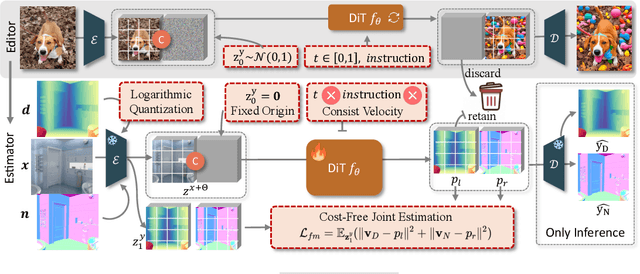


Abstract:Leveraging visual priors from pre-trained text-to-image (T2I) generative models has shown success in dense prediction. However, dense prediction is inherently an image-to-image task, suggesting that image editing models, rather than T2I generative models, may be a more suitable foundation for fine-tuning. Motivated by this, we conduct a systematic analysis of the fine-tuning behaviors of both editors and generators for dense geometry estimation. Our findings show that editing models possess inherent structural priors, which enable them to converge more stably by ``refining" their innate features, and ultimately achieve higher performance than their generative counterparts. Based on these findings, we introduce \textbf{FE2E}, a framework that pioneeringly adapts an advanced editing model based on Diffusion Transformer (DiT) architecture for dense geometry prediction. Specifically, to tailor the editor for this deterministic task, we reformulate the editor's original flow matching loss into the ``consistent velocity" training objective. And we use logarithmic quantization to resolve the precision conflict between the editor's native BFloat16 format and the high precision demand of our tasks. Additionally, we leverage the DiT's global attention for a cost-free joint estimation of depth and normals in a single forward pass, enabling their supervisory signals to mutually enhance each other. Without scaling up the training data, FE2E achieves impressive performance improvements in zero-shot monocular depth and normal estimation across multiple datasets. Notably, it achieves over 35\% performance gains on the ETH3D dataset and outperforms the DepthAnything series, which is trained on 100$\times$ data. The project page can be accessed \href{https://amap-ml.github.io/FE2E/}{here}.
Comprehensive Comparison Network: a framework for locality-aware, routes-comparable and interpretable route recommendation
Aug 12, 2025Abstract:Route recommendation (RR) is a core task of route planning in the Amap app, with the goal of recommending the optimal route among candidate routes to users. Unlike traditional recommendation methods, insights into the local quality of routes and comparisons between candidate routes are crucial for enhancing recommendation performance but often overlooked in previous studies. To achieve these, we propose a novel model called Comprehensive Comparison Network (CCN). CCN not only uses query-level features (e.g. user features) and item-level features (e.g. route features, item embedding) that are common in traditional recommendations, but also introduces comparison-level features which describe the non-overlapping segments between different routes to capture the local quality of routes. The key component Comprehensive Comparison Block (CCB) in CCN is designed to enable comparisons between routes. CCB includes a Comprehensive Comparison Operator (CCO) and a multi-scenario MLP, which can update the representations of candidate routes based on a comprehensive comparison. By stacking multiple CCBs, CCN can determine the final scores of candidate routes and recommend the optimal one to the user. Additionally, since routes directly affect the costs and risks experienced by users, the RR model must be interpretable for online deployment. Therefore, we designed an interpretable pair scoring network to achieve interpretability. Both offline and online experiments demonstrate that CCN significantly improves RR performance and exhibits strong interpretability. CCN has been fully deployed in the Amap app for over a year, providing stable and optimal benefits for route recommendations.
Omni-Effects: Unified and Spatially-Controllable Visual Effects Generation
Aug 12, 2025Abstract:Visual effects (VFX) are essential visual enhancements fundamental to modern cinematic production. Although video generation models offer cost-efficient solutions for VFX production, current methods are constrained by per-effect LoRA training, which limits generation to single effects. This fundamental limitation impedes applications that require spatially controllable composite effects, i.e., the concurrent generation of multiple effects at designated locations. However, integrating diverse effects into a unified framework faces major challenges: interference from effect variations and spatial uncontrollability during multi-VFX joint training. To tackle these challenges, we propose Omni-Effects, a first unified framework capable of generating prompt-guided effects and spatially controllable composite effects. The core of our framework comprises two key innovations: (1) LoRA-based Mixture of Experts (LoRA-MoE), which employs a group of expert LoRAs, integrating diverse effects within a unified model while effectively mitigating cross-task interference. (2) Spatial-Aware Prompt (SAP) incorporates spatial mask information into the text token, enabling precise spatial control. Furthermore, we introduce an Independent-Information Flow (IIF) module integrated within the SAP, isolating the control signals corresponding to individual effects to prevent any unwanted blending. To facilitate this research, we construct a comprehensive VFX dataset Omni-VFX via a novel data collection pipeline combining image editing and First-Last Frame-to-Video (FLF2V) synthesis, and introduce a dedicated VFX evaluation framework for validating model performance. Extensive experiments demonstrate that Omni-Effects achieves precise spatial control and diverse effect generation, enabling users to specify both the category and location of desired effects.
HS-STAR: Hierarchical Sampling for Self-Taught Reasoners via Difficulty Estimation and Budget Reallocation
May 26, 2025Abstract:Self-taught reasoners (STaRs) enhance the mathematical reasoning abilities of large language models (LLMs) by leveraging self-generated responses for self-training. Recent studies have incorporated reward models to guide response selection or decoding, aiming to obtain higher-quality data. However, they typically allocate a uniform sampling budget across all problems, overlooking the varying utility of problems at different difficulty levels. In this work, we conduct an empirical study and find that problems near the boundary of the LLM's reasoning capability offer significantly greater learning utility than both easy and overly difficult ones. To identify and exploit such problems, we propose HS-STaR, a Hierarchical Sampling framework for Self-Taught Reasoners. Given a fixed sampling budget, HS-STaR first performs lightweight pre-sampling with a reward-guided difficulty estimation strategy to efficiently identify boundary-level problems. Subsequently, it dynamically reallocates the remaining budget toward these high-utility problems during a re-sampling phase, maximizing the generation of valuable training data. Extensive experiments across multiple reasoning benchmarks and backbone LLMs demonstrate that HS-STaR significantly outperforms other baselines without requiring additional sampling budget.
UniVG-R1: Reasoning Guided Universal Visual Grounding with Reinforcement Learning
May 20, 2025Abstract:Traditional visual grounding methods primarily focus on single-image scenarios with simple textual references. However, extending these methods to real-world scenarios that involve implicit and complex instructions, particularly in conjunction with multiple images, poses significant challenges, which is mainly due to the lack of advanced reasoning ability across diverse multi-modal contexts. In this work, we aim to address the more practical universal grounding task, and propose UniVG-R1, a reasoning guided multimodal large language model (MLLM) for universal visual grounding, which enhances reasoning capabilities through reinforcement learning (RL) combined with cold-start data. Specifically, we first construct a high-quality Chain-of-Thought (CoT) grounding dataset, annotated with detailed reasoning chains, to guide the model towards correct reasoning paths via supervised fine-tuning. Subsequently, we perform rule-based reinforcement learning to encourage the model to identify correct reasoning chains, thereby incentivizing its reasoning capabilities. In addition, we identify a difficulty bias arising from the prevalence of easy samples as RL training progresses, and we propose a difficulty-aware weight adjustment strategy to further strengthen the performance. Experimental results demonstrate the effectiveness of UniVG-R1, which achieves state-of-the-art performance on MIG-Bench with a 9.1% improvement over the previous method. Furthermore, our model exhibits strong generalizability, achieving an average improvement of 23.4% in zero-shot performance across four image and video reasoning grounding benchmarks. The project page can be accessed at https://amap-ml.github.io/UniVG-R1-page/.
Effective Probabilistic Time Series Forecasting with Fourier Adaptive Noise-Separated Diffusion
May 16, 2025Abstract:We propose the Fourier Adaptive Lite Diffusion Architecture (FALDA), a novel probabilistic framework for time series forecasting. First, we introduce the Diffusion Model for Residual Regression (DMRR) framework, which unifies diffusion-based probabilistic regression methods. Within this framework, FALDA leverages Fourier-based decomposition to incorporate a component-specific architecture, enabling tailored modeling of individual temporal components. A conditional diffusion model is utilized to estimate the future noise term, while our proposed lightweight denoiser, DEMA (Decomposition MLP with AdaLN), conditions on the historical noise term to enhance denoising performance. Through mathematical analysis and empirical validation, we demonstrate that FALDA effectively reduces epistemic uncertainty, allowing probabilistic learning to primarily focus on aleatoric uncertainty. Experiments on six real-world benchmarks demonstrate that FALDA consistently outperforms existing probabilistic forecasting approaches across most datasets for long-term time series forecasting while achieving enhanced computational efficiency without compromising accuracy. Notably, FALDA also achieves superior overall performance compared to state-of-the-art (SOTA) point forecasting approaches, with improvements of up to 9%.
FLUX-Text: A Simple and Advanced Diffusion Transformer Baseline for Scene Text Editing
May 06, 2025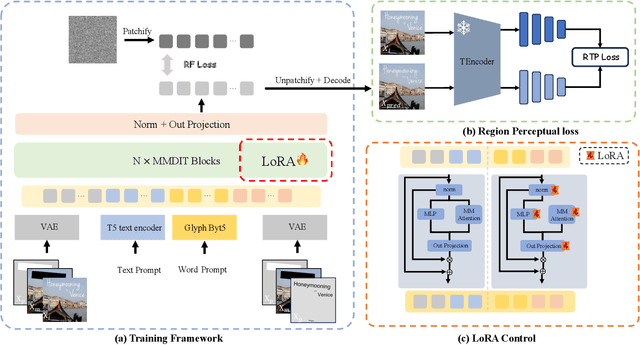

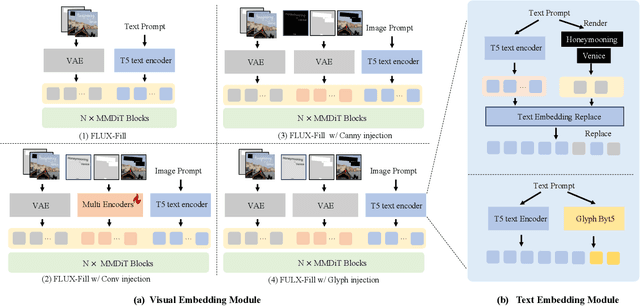

Abstract:The task of scene text editing is to modify or add texts on images while maintaining the fidelity of newly generated text and visual coherence with the background. Recent works based on latent diffusion models (LDM) show improved text editing results, yet still face challenges and often generate inaccurate or unrecognizable characters, especially for non-Latin ones (\eg, Chinese), which have complex glyph structures. To address these issues, we present FLUX-Text, a simple and advanced multilingual scene text editing framework based on FLUX-Fill. Specifically, we carefully investigate glyph conditioning, considering both visual and textual modalities. To retain the original generative capabilities of FLUX-Fill while enhancing its understanding and generation of glyphs, we propose lightweight glyph and text embedding modules. Owning to the lightweight design, FLUX-Text is trained only with $100K$ training examples compared to current popular methods trained with 2.9M ones. With no bells and whistles, our method achieves state-of-the-art performance on text editing tasks. Qualitative and quantitative experiments on the public datasets demonstrate that our method surpasses previous works in text fidelity.
FingER: Content Aware Fine-grained Evaluation with Reasoning for AI-Generated Videos
Apr 14, 2025



Abstract:Recent advances in video generation have posed great challenges in the assessment of AI-generated content, particularly with the emergence of increasingly sophisticated models. The various inconsistencies and defects observed in such videos are inherently complex, making overall scoring notoriously difficult. In this paper, we emphasize the critical importance of integrating fine-grained reasoning into video evaluation, and we propose $\textbf{F}$ing$\textbf{ER}$, a novel entity-level reasoning evaluation framework that first automatically generates $\textbf{F}$ine-grained $\textbf{E}$ntity-level questions, and then answers those questions by a $\textbf{R}$easoning model with scores, which can be subsequently weighted summed to an overall score for different applications. Specifically, we leverage LLMs to derive entity-level questions across five distinct perspectives, which (i) often focus on some specific entities of the content, thereby making answering or scoring much easier by MLLMs, and (ii) are more interpretable. Then we construct a FingER dataset, consisting of approximately 3.3k videos and corresponding 60k fine-grained QA annotations, each with detailed reasons. Based on that, we further investigate various training protocols to best incentivize the reasoning capability of MLLMs for correct answer prediction. Extensive experiments demonstrate that a reasoning model trained using Group Relative Policy Optimization (GRPO) with a cold-start strategy achieves the best performance. Notably, our model surpasses existing methods by a relative margin of $11.8\%$ on GenAI-Bench and $5.5\%$ on MonetBench with only 3.3k training videos, which is at most one-tenth of the training samples utilized by other methods. Our code and dataset will be released soon.
GPG: A Simple and Strong Reinforcement Learning Baseline for Model Reasoning
Apr 03, 2025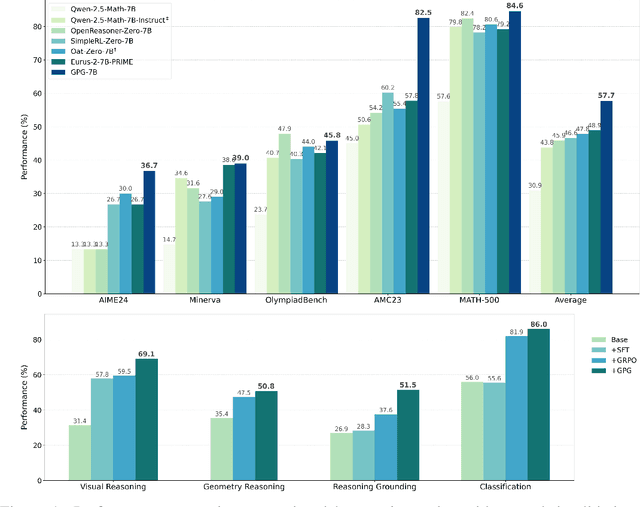

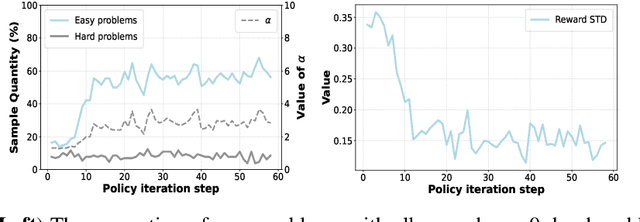

Abstract:Reinforcement Learning (RL) can directly enhance the reasoning capabilities of large language models without extensive reliance on Supervised Fine-Tuning (SFT). In this work, we revisit the traditional Policy Gradient (PG) mechanism and propose a minimalist RL approach termed Group Policy Gradient (GPG). Unlike conventional methods, GPG directly optimize the original RL objective, thus obviating the need for surrogate loss functions. As illustrated in our paper, by eliminating both the critic and reference models, and avoiding KL divergence constraints, our approach significantly simplifies the training process when compared to Group Relative Policy Optimization (GRPO). Our approach achieves superior performance without relying on auxiliary techniques or adjustments. Extensive experiments demonstrate that our method not only reduces computational costs but also consistently outperforms GRPO across various unimodal and multimodal tasks. Our code is available at https://github.com/AMAP-ML/GPG.
 Add to Chrome
Add to Chrome Add to Firefox
Add to Firefox Add to Edge
Add to Edge